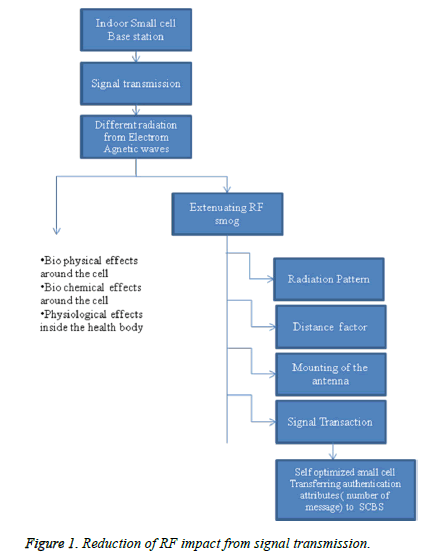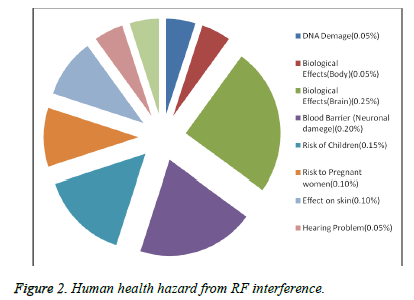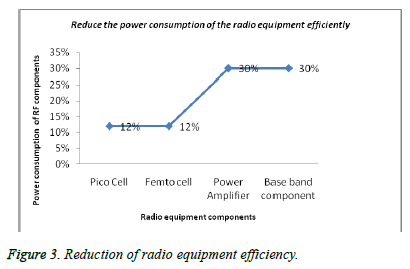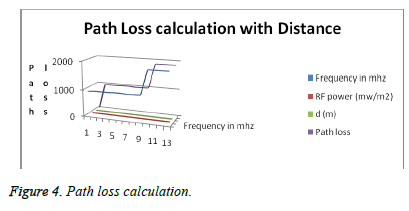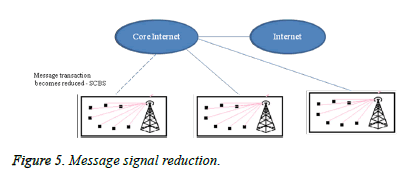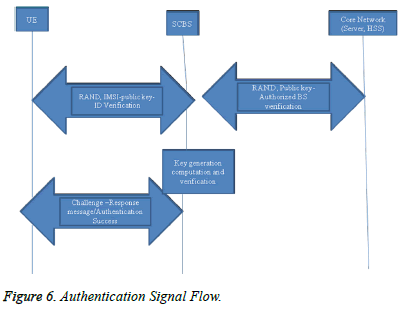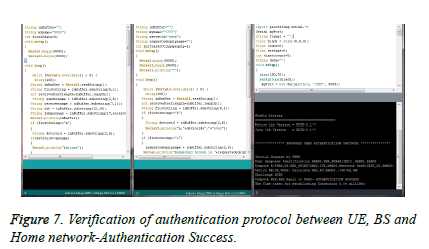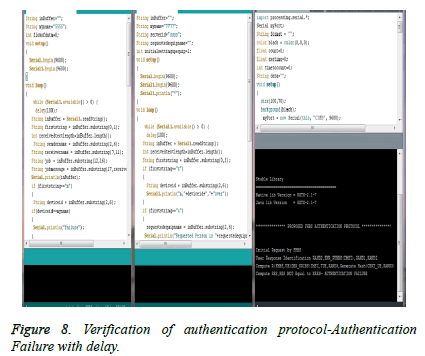ISSN: 0970-938X (Print) | 0976-1683 (Electronic)
Biomedical Research
An International Journal of Medical Sciences
Research Article - Biomedical Research (2016) Computational Life Sciences and Smarter Technological Advancement
Radio frequency smog reduction from future heterogeneous base station
In modern era, communication technologies need a significant development. In order to improve the capacity and coverage, a massive technological advancement has become a widespread subject. However, the pollution caused by Radio Frequency Electromagnetic Field (RF-EMF) radiation is considered as the greatest environmental hazard. Hence, the present analysis proposes a suitable solution to mitigate the RF pollution or smog from base station installation in hot spot areas. On the basis of mitigating the RF frequencies, much amendment has to be made on the design of base station, decreasing of signal transmission between the entities and also considering the distance. Heterogeneous networks security will increase the signalling transmission for getting user authentication. On the basis of authentication, fast authentication and re-authentication, this paper mainly focuses on the reduction of communication signal transmission between the entities. Before data transmission, the entities have to get the mutual negotiation. The performance metrics of base station depends on power required for transmission and reception, radiation pattern, distance between the entities and message transmission that leads to considerably decrease the R. F. smog and interference reduction. The main aim of this paper extenuates human health care from RF field interference occurring in Future Heterogeneous Base Station (FHBS) and standard limitation is provided in the RF interference range.
Keywords
Radio frequency, Electromagnetic field, Mobile base station, Human health care, Authentication signal reduction.
Introduction
All over the world, long term exposure due to base-station Radio Frequency Electromagnetic Field (RF-EMF) radiation has been recognized as serious health concern. Research efforts have increased in response to complaints from public and recommendation from World Health Organization’s (WHO), all government sectors announced limitation of usage frequencies against the base-station installation. Numerous solutions have been given to meet heterogeneous wireless communication demand. This analysis discusses the adverse effects of RF-EMF interference in Future Heterogeneous Base Station (FHBS) particularly in hot spot areas.
Therefore, these networks automatically regulate the transmitter power in the base station based upon the users distance. If the base-stations are situated nearer to the user, then it would produce the low level of EMF, while far away from user, it produces high level EMF. Similarly, when the base stations are situated nearer to the mobile phone users, the transmitter power required by the mobile phone is low and EMF production is relatively low. If base stations are situated far away from the user, then the power required is generally higher, and produces higher EMF [1,2]. Hence, nearer the base station, lower the EMF and better the reception. Several previous studies conducted earlier reported that base stations works at lower power that leads to low interference of RF pollution. Further, the EMF level also low in the base stations which is similar to broadcast television and radio.
This paper evaluates the interference of Radio Frequency (RF) from mobile base stations and their adverse effect on human beings. Various studies [3-5] have identified that these RF fields could cause carcinogenic to human. Even though various study have stated the adverse effect, there is no previous evidence of environmental exposure to RF fields comes from base stations may enhance the cancer risk or any other risk. The radio frequency affected the normal biological cells of the individual by inducing the electromagnetic effects at increase in temperature. These effects are attributed to the induced electromagnetic inside the biological cells of the body which is possibly more harmful. Individuals who are living nearer to the base station or frequently exposed to the emissions of low level wireless antenna have felt various severe symptoms at the time and after its use such as fatigue, dizziness, ringing in the ears, headache, heart palpitation, tingling sensation in the skin of the head, burning, loss of memory, sleep disturbance, lack of concentration, reaction time and disturbance in the digestive system etc. The interference of base station EMW and some medical devices are reducing the risk in newer design of small cell coverage. Since the cellular base stations are successfully extenuating RF signal interference through thoughtful radio system knowledge with proper cell planning, frequency and bandwidth allocation. Thus the heterogeneity in the wireless communication a new technology development of the small cell base station was introduced.
The present paper proposes the protocol based on Future Heterogeneous Base Station (FHBS) network which has been widely recognized as a solution to effectively reduce the RF pollution and power consumption. This will support in attaining the spectral efficiency goal and depletion of RF pollution by solving the ‘capacity hotspot’ problem where there is a high level of subscriber concentration and simultaneously the ‘coverage hole’ problem due to poor signal quality (Figure 1).
Radiation Effects and EMF Emissions
Generally, radiation is exhibited by both man-made and natural radiation and they are electromagnetic in nature. In general, there are two categories of electromagnetic radiation which includes the ionizing and non-ionizing radiation. From the research it is evident that the ionizing radiation has a capability to eradicate the electron which is from the atom’s orbit of an atom, where it becomes an ionized atom to cause health hazard [6]. For instance, X-rays are perceived as ionized material due to high [7-9] EMF frequency. However, in the case of nonionizing radiation it lacks sufficient energy to ionize the atoms. Some of the non-ionisizing radiations are microwave radiation [10-12] visible light and radio wave frequency (RF) energy.
In the current technological world, the society depends on mobile phones for communications purpose at work, school and home. These mobile phones generate the electromagnetic waves like X-ray and visible light. However, the range of electromagnetic radiation falls between non-ionizing and ionizing ranges of frequency, especially for mobile communication can be in the range of 450-2200 MHz but energy is directly proportional to the wave frequency.
Due to absorption of energy, RF fields ranged from at a lower level of 10 GHz to 1 MHz exposed into tissues and give heating. The penetration depth based on the frequency of the field and is greater for lower frequencies. Specific Absorption Rate (SAR) is the quantity used to measure the absorption of RF energy [13,14] within a given tissue mass and it is expressed in units of watts per kilogram (W/kg or mW/Kg). The quantity of RF fields between about 1 MHz and 10 GHz is measured using SAR. People who are exposed to RF fields in the SAR at 4 W/kg, produces several adverse health effects. Similarly, the range at 10 GHz of RF fields are absorbed at the surface of the skin, only few energy enter into the deepen tissues, while the above 10 GHz of RF fields exposed at power densities over 1000 W/m2 produces severe health effects like skin burns and eye cataracts.
Potential Bio-Effects of Exposure to Microwave/RF Radiation
It deals with the biological entities [15-17] and electromagnetic fields. In the human body, more number of molecules weakly interacts with low frequency bands or EMF in the RF. One such interaction is energy absorption from the fields that may cause tissue to high degree of temperature; many intense fields will give higher heating that leads to several biological effects ranging from muscle relaxation (as produced by a diathermy device) to burns. There is a difficulty to prove the electromagnetism direct effects on human health and reported life-threatening interferences from EMF are limited to medical devices such as electronic implants, pacemakers and others.
Generally more biological effects of exposure to RF/ microwave radiation are related to heating of tissues which is commonly referred as “thermal effects”, mainly due to the RF energy ability to heat biological tissue [18-21] . However, the evidence of harmful biological effects is unproven. Nonthermal effects have been proved in animals such as teratogenesis, carcinogenesis etc. but not tested on humans. Some of the biological effects are tested in humans are burns from contact with spectacles, metal implants RF (induction) burns, formation of Cataract (from eye exposure). The role of long-term revelation to high radio frequency radiation [22-24] emitted either from mobile phones or from base stations and its relations with human's hormone profiles. This radiation effects on pituitary-adrenal axis represented in the reduction of ACTH, cortisol, thyroid hormones, prolactin in young females, and testosterone levels.
Pulsed microwave radiation [25-27] used in base station of cellular device can non-thermally affect these various biological (electrical) activities and provoke adverse health reactions. Weak radiation can entail only correspondingly weak effects, and vice versa. Even though the non-thermal electromagnetic compatibility between energized electronic equipment used in hospitals and aircraft can be accepted, the human can’t accept these radiations. To be more specific it was identified that these radiations cause adverse effect to human brain functioning, especially these affect the electro-chemistry and electrical activities in human body, degrades the immune system and other health reactions [7,28-30]. Moreover, these effects were experience by extensive mobile phones user and other who are subjected to long-term radiation exposure from BS.
Furthermore, the studies have identified that [8,9,31,32] that these microwave radiation cause a serious damage to hippocampus region of the brain which results in memory loss related issues and some children had neural problems like epileptic seizures. However, the future study’s findings failed to address these issues who adopted the ability of a visible light (such as a stroboscope) flashing technique. In this technique targeted the photosensitive human sampled where every 15-20 times per second the light was flashed which provoked the seizures in the five percentage minimum of epileptics.
Evidence from both animal and human studies on association between exposure and outcome seems to be insufficient and inconsistent (Figure 2) [3]. This is perhaps due to the methodological challenge involved in distinguishing between exposed RF field from base station and characterize the high and low RF signals in the environment [4]. Despite the fact that few studies of EMF research have identified changes in behaviour, cognition and brain wave patterns after exposure to RF fields produced by mobile phones. However, there is lack of convincing evidence about cardiovascular function or altered sleep pattern. Few individuals have felt the non-specific symptoms during the exposure to RF fields produced from EMF devices, and base stations. According to WHO [18,33] fact sheet report “Electromagnetic Hypersensitivity", the EMF does not cause any symptoms. In spite of that, there is a necessary to understand the individual’s difficulty from these symptoms. Overall, there is no convincing evidence associated with RF signals from base station produced adverse health effects. Since wireless networks generally give lower RF signals in comparison with base stations, so that there is no adverse health effects were observed.
Base Station Mitigation Effects on RF
The following are the factors [34] that affect RF interference.
Signal transmission: During the telephonic communication, the signals from the user’s equipment and base station are sent back and forth. The base stations produced by the RF waves are given off into the environment, where people are being exposed to them.
Mounting of the antenna: For various reasons, the individuals are exposed to radio waves from cell phone tower antennas. Some of the reasons are the signals are intermittently transmitted not constantly, the mounted antennas are generally high above the ground level and the power levels are comparatively low.
Distance factor: A person who is highly exposed to RF levels in nearby cell phone tower. If the cellular antenna is fixed on a roof, it is feasible that the individual who are exposed to RF levels is higher than the ground level.
Reducing exposure level of radiation: Based on the building construction materials, the RF energy level is lower in inside the buildings than the outside. Materials like cement block or wood decreases the RF radiation exposure level by about 10 factors.
Antenna radiation pattern: The radiation pattern is identified to be hundred to thousand times very low when placed in behind than in front. Hence, if the antenna is placed on the behind the building the exposure is identified to have less radiation.
Small Cell and Interference Mitigation
The term SC is known as the minimum powered radio access nodes that range from 10 meters to 2 kilometers. These access node function both in licensed as well as unlicensed spectrum. Small cells comprises of microcells, picocells and femtocells. The Microcells and Picocells have also in the range of a few hundred meters to kilometers, but they vary from femtocells in that they do not always have self-management and selforganising abilities. These SCs are small in size when compared to the microcells in mobile phones with a range of ten or more than ten kilometers. Hence, these remains as constraint to the mobile operators as these operators are struggling highly to improve due to the mobile data traffic. Even though these are considered to be ineffective users or the operators still consider the Mobile data offloading as the most efficient way of the radio spectrum. However, to some degree these network operators have evaded with an economic growth and encouraged the adoption of WiFi both in office and home, 3G was the redesign of 2G spectrum and in later stage the LTE was introduced an additional spectrum. Moreover, these SCs are considered to be the most important element to 3G data offloading and other researcher consider that these SCs are important during LTE Advanced spectrum management most effectively in comparison to other macro cells.
The networks are recognized by the distributed radio technology which comprises of remote radio heads and centralized baseband units. In order to focus or enhance the small cell coverage by using the technology is Beam forming (focusing a radio signal on a very specific area). In all these SC approaches the main factor which needs to be concentrate is controlling the SC coverage by operators of mobile network. These cells give a little radio footprint that range between 10 meters inside the in-building locations and urban areas and 2 km for a rural areas. The best approach to using LTE networks by operators is Small cells, especially femtocell. A LTE femtocell station is mentioned to as the Home eNode B (HeNB). This is an efficient method to increasing the capacity of the cell and coverage of indoor. The important issue in the present femtocell deployment is the interference of cross-tier between adjacent HeNBs and users of macrocell. The interface mitigation can be achieved if the base station is designed in such a way that in the network every cell must perform well with a reduced congestion, good signal, or no call drop [35]. In addition the RF is also required with enough quality and coverage to obtain this goal, as it is significant to maintain service quality to all users.
Energy Distribution-Base Station
The network operators have turned out to concentrate more on FHBS, due to the following reasons: Good energy resource, for the growth of wireless communication. This energy consumption of [36] base-stations will give different opportunities for future heterogeneous networks. Radio equipment dominated the energy consumption of a FHBS. Hence, to reduce the energy consumption of the radio equipment efficiently, it is essential to quantify the energy consumption over the different radio equipment components and to focus on the main consumers (Figure 3).
Energy adaptation opportunities
Normally, base-stations are designed for maximal traffic load and high variations in the power saving parameter. To evaluate the performance of utilizing base station traffic load many parameters were adopted. From the Figure 3, it is illustrated that the variation of BS depends on various aspects like heavy traffic period, medium traffic, heterogeneous interference period and sleep mode period.
Path loss
Both the transmission and reception power of base station depends on the strength of a RF-EMF field. Since multiple channels are present in the base station, worsely affect the signal transmission, power and frequency of transmission (Figure 4 and Table 1).
| CDMA (850&890 MHz) | |||
|---|---|---|---|
| RSSI (dBm) | Path Loss | RSSI (dBm) | Path Loss (Db) |
| 1.94925 | 37.05075 | 1.54983 | 37.45017 |
| -6.00955 | 45.0095 | -6.40897 | 45.40897 |
| -11.115 | 50.115 | -11.5144 | 50.51442 |
| 13.6138 | 52.61378 | -14.032 | 53.0132 |
| -15.552 | 54.55198 | -15.9514 | 54.9514 |
| GSM900-900&960 (MHz) | |||
| 1.45278 | 37.546722 | 0.8922 | 38.1078 |
| -6.50602 | 45.50602 | -7.0666 | 46-0666 |
| -116115 | 50.61147 | -12.1721 | 51.17205 |
| -14.1103 | 53.11025 | -14.6708 | 53.67082 |
| -16.0485 | 55.04845 | -16.609 | 55.60902 |
| GSM 1800-1800&1880 (MHz) | |||
| -4.56782 | 43.56782 | -4.94553 | 43.94553 |
| -12.5266 | 51.52662 | -12.9043 | 51.90433 |
| -17.6321 | 56.63207 | -18.0098 | 57.0097 |
| -20.1309 | 59.13085 | -20.5086 | 59.50855 |
| -22.0691 | 61.06905 | -22.4468 | 61.95745 |
| 3G (2100&2170 MHz) | |||
| -5.90676 | 44.90676 | -6.19157 | 45.19157 |
| 13.8656 | 52.86556 | -14.1504 | 53.15037 |
| -18.971 | 57-97101 | -19.2558 | 58-25582 |
| -21.4698 | 60.46978 | -217546 | 60.754559 |
| -23.4079 | 62.40798 | -23.6928 | 62.69279 |
Table 1. Path loss vs various distance.
Small Cell Base Station Interference Reduction
Small cells base station (SCAP) gives flexibility and improved the capabilities of Quality of Service (QoS) at an attractive cost. The implementation of infrastructure of small cell provides the eco-friendly environment that decreases the cell towers (maybe even eventually eliminate them) and it gives a clean signal with low power. The intensity of RF radiation from the mobile phones is higher than base stations, but less than the local television and radio stations at the ground level.
In comparison with mobile hot spot communication or broad band radio communication, it is better to select within the desired communication. From the perspective of radiation level it is always considered to have a better FHBS for controlling, communicating and to have an efficient connection with heterogeneous wireless communication. However, in general inside the residential building or campus, the radiation power is considered to limited always. Further, in the FHBS a decreased power transmission can be obtained with a multi system antenna. Even though large scale multiple-antenna system plays a significant role in development, the small cell base station becomes the key to deploy either of these systems.
A typical base station has several transceivers allowing operation in several different frequencies (UHF/VHF) and different technologies CDMA, GSM, 3G, 4G, and futuristic 5G directions of the cell in the system. Finally, another issue to be taken into account is the public opinion worrying about the multiplication of radio transmitters in the neighbourhood and inside living areas. People are more and more complaining about the multiplication of cellular transmitters near their home. In many countries, a mood of suspicion about radio waves is noticeable, and more and more lawsuit is brought against the installation of base station (Figure 5).
Reduction in signalling messages: Several techniques have been adopted for selecting a serving BS for a wireless communication network user. The present review proposed a communication protocol (EAP AKA’) for a multiple candidate BS for identifying the user, with each user base station being a candidate for selection as the serving base station for the terminal.
In the main beam the RF field’s inner portion much stronger than outside due to the narrow beam pattern a person exposed to RF field experiences the radiation’s adverse effect and the degree of exposure is estimated based on the distance and main beam direction. However, in general these signal are weak at the ground level of antenna tower, hence only minimum damage is faced when the person is nearby In many BSs, the strength of the signal near the ground level gradually increases with distance from the tower and attains maximum strength between 50-200 meters from the tower bottom, and further reduces at still considerable distances. In all the bottom places, there is a low level of signals in compared to regulatory guidelines.
Population exposure of radiation pattern in small cell base station generally depends on the power, antenna type and distance. In the case of indoor FHBS, special type of antennas are used as its position, angle elevation and the directivities are different from other normal type antennas that leads to low production of radiation energy. These kinds of antennas are basically designed to emit energy in useful direction apart from unutilized areas, where it emits low energy. In wireless communication various optimal exposure guidelines have been proposed that includes co-channel base station interferences produced a Maximum Permissible Exposure (MPE) limit. Sometimes this limit exceed by uncontrolled access of public due to different antennas are used for distinct services. Therefore, clear safety analyses are necessary to examine the compliance. The important objective of the RF exposure standards is to suppress the exposures on biological effects of electromagnetic fields and also decrease the severe human health hazards. Earlier researches carried out the short term EMF exposure in animals but sometimes using high power exposure. Even though only few humans and animals studies used the long term exposure of EMF. Studies reported previously on deleterious effect of RF are mainly due to high level of heating. A different guidelines of exposure included safety factors to maintain the low levels of exposure which caused the hazardous effects to humans.
Signal Transmission Reduction
To reduce the message transaction between wireless communications, results less interference from radio frequency. There are two types of handovers inter cell and intra cell communication. Once the small cell base station is placed inside the area of the required environment, not required or unused areas are unaffected from the harmfulness. Before data transfer, the small cell access point or FHBS mutually authenticated from user equipment and the access network. If the authentication message transaction is more, then the RF interference impact is also high in the public areas .So the number of authentication transaction is being reduced in forth coming wireless communication.
Previously in 2G, 3G and beyond 3G [37] technology was implemented with standard authentication protocols like EAPTLS, EAP-AKA, LEAP, etc. On the basis of distance, coverage area, fast mobility of the User equipment may split the control and user plane of the radio link into scalable dense small cells. The centralized control management enables fast information exchange with less interference from radiation. Before transmitting of data, reducing the signal load (message) between entities is `a major challenge in the field of mobile cellular communication. Local exchange of information and far distance message exchange will cover different cell area, which consequences various radio wave interference in the required users and not required users. Authenticating the small cell base station is a most important process in the field of security. It has to get authenticated from user equipment as well as from the access network.
Proposed Communication Protocol Description
The nature of the self-optimized, cooperative ability of small cell base station gets the acknowledgement from core network HSS and User Equipment (UE). After the mutual authentication signal IMSI of the UE is transferred to FHBS. Core network transferring all the credentials to FHBS. Computational algorithm [38,39] with key, cryptographic hash generation and verification were done in the base station itself. Consequently the numbers of messages during authentication were reduced, thereby reducing signal transmission and RF frequency exposure (Figure 6).
Formal verification of authentication protocol will use Arduino tool to verify the authentication protocol signalling flow. It is a tool for routinely analysing the authentication protocol and running on a quad co-processor 4GB memory computing device.
From the Figures 7 and 8 it clearly visualized that the signal transmission between FHBS, user equipment and home network. Authentication signal flow would negotiate key generation computation of hash algorithm. It reduces the delay on the link and reducing transmission time interval compared to other networks. The authentication protocol between FHBS and UE allows rapid re-transmissions of received data,reducing the number of radio link messages and the associated delay. This can lower the number of EMF interferences the health hazard from radio link messages, thus increasing the efficiency of the network as a whole.
From the Table 2, it is observed that the proposed method reduces signal transaction between AAA server and base station with respect to data rates and corresponding messages. Using automatic data configuration and intelligent algorithm, the centralized network management system in small cell BS, provides reauthentication without the intervention of home server. Re-authentication offers much lower delay, reduction in authentication load and less complexity than the full authentication.
| Signal processing | Heterogeneous Authentication signal flow | Proposed Method | Proposed Re-authentication Signal flow |
|---|---|---|---|
| Base station(BS) Request | * | * | * |
| UE/MS Acknowledgement to BS | * | * | * |
| Base station(BS) to AAA server | * | - | - |
| AAA to Home Server(HS) | * | *(BS to HS) | - |
| Home Server to AAA server | * | - | - |
| AAA server to BS | * | * | - |
| BS to UE/MS | * | * | * |
| UE/MS to Base station | * | * | * |
Table 2. Signal reduction.
Conclusion
It is concluded that authentication protocol used in FHBS reduces the human health hazard from radio frequency interference aspects. This paper dealt the thorough analysis of energy requirement (RSSI) and path loss characteristics of heterogeneous networks. The performance characteristics of FHBS transmission density have much influence on throughput and energy efficiency of the network. Future studies need to be accomplished to prove this empirically. The centralized control management of FHBS enables fast information exchange with less interference from electromagnetic radiation. It is assumed that the proposed authentication signal flow would reduce the signal transmission; thereby the radio frequency exposure between base station and home server is reduced significantly. However, future studies need to be conducted to prove this empirically. Summarizing the above points, it can be affirmed that the developed mechanism can provide a high level of security guarantee in the interworking networks concerning the human health hazard as well. In addition this proposed algorithm is simple and robust. It also offers effective security with minimal changes implemented compared to the existing infrastructure to achieve healthy measures in heterogeneous networks.
References
- Gavan J, Tapuchi S. Mitigation techniques for enhancing mobile radio EMC performances, In 2011 XXXth URSI General Assembly and Scientific Symposium. IEEE 2011; 1-4.
- Hyland GJ. Potential Adverse Health Impacts of Mobile Technology, Memorandum, Department of physics, University of Warwick and International Institute of Biophysics 2000.
- Luiis GN, Newry RJ, King BV, John AR. Mobile phone radiation induces reactive oxygen species production and DNA damage in human spermatozoa in vitro. PLoS One 2009; 4: 6440-6446.
- Mousa A. Electromagnetic Radiation Measurements and Safety Issues of some Cellular Base Stations in Nablus. J Eng Sci Technol Rev 2011; 4: 35-42.
- psrast.org. Physicians and Scientists for Responsible Application of science and Technology, Mobile phones-safety Problems, 2004.
- Rubin GJ, Nieto-Hernandez R, Wessely S. Idiopathic environmental intolerance attributed to electromagnetic fields (formerly ‘electromagnetic hypersensitivity’): an updated systematic review of provocation studies. Bioelectromagnetics 2009; 31: 1-11.
- Cuadras A, Gasulla M, Ferrari V. Thermal energy harvesting through pyroelectricity. Sensors Actuat Physical 2010.
- Atli E, Unlu H. The effects of microwave frequency electromagnetic fields on the development of Drosophila melanogaster. Int J Radiat Biol 2006; 82: 435-441.
- Balmori A. Possible effects of electromagnetic fields from phone masts on a population of White Stork (Ciconia ciconia). Electromagn Biol Med 2005; 24: 109-119.
- Beasond RC, Semm P. Responses of neurons to an amplitude modulated microwave stimulas. Neurosci Lett 2002; 333: 175-178.
- Belyaev IY. Nonthermal Biological Effects of Microwaves: Current Knowledge, Further Perspective, and Urgent Needs. Electromagn Biol Med 2005; 24: 375-403.
- Bernhardt JH. Non-ionizing radiation safety: radiofrequency radiation, electric and magnetic fields. Phys Med Biol 1992; 37: 80-84.
- World Health Organization. What are the health risks associated with mobilephones and their base stations? Online Q&A 2005.
- Roosli M, Hug K. Wireless communication fields and non-specific symptoms of ill health: a literature review. Wien Med Wochenschr 2011; 10: 240-250.
- Roosli M, Frei P, Mohler E, Hug K. Systematic review on the health effects of exposure to radiofrequency electromagnetic fields from mobile phone base stations. Bull World Health Organ 2010; 88: 887-896.
- Rubin GJ, Nieto-Hernandez R, Wessely S. Idiopathic environmental intolerance attributed to electromagnetic fields (formerly ‘electromagnetic hypersensitivity’): an updated systematic review of provocation studies. Bioelectromagnetics 2009; 31: 1-11.
- Salford L, Henrietta N, Arne B, Gustav G. The mammalian brain in the electro- magnetic fields designed by man with special reference to blood brain barrier function, neuronal damage and possible physical mechanisms. Prog Theor Phys Suppl (Japan) 2008; 173: 283-309.
- TarusawaY, Ohshita K, Suzuki Y, Nojima T. Experimental estimation of EMI from cellular base-station antennas on implantable cardiac pacemakers. IEEE Transactions on Electromagnetic Compatibility 2005; 47: 938-950.
- Albert EN. Light and electron microscopic observations on the blood-brain barrier after microwave irradiation. In Symposium on Biological Effects and Measurements of Radiofrequency Microwaves 1977; Washington, DC: DHEW (HEW Publications), FDA77-8026, p294-304. As cited in RSC, 1999.
- Armstrong B. Association between exposure to pulsed electromagnetic fields and cancer in electric utility workers in Quebec, Canada and France. Am J Epidemiol 1994; 140: 805-820.
- Balcer-Kubiczek EK, Harrison GH. Neoplastic transformation of C3H/10T ½ cells following exposure to 120-Hz modulated 2.45-GHz microwaves and phorbol ester tumour promoter. Radiat. Res 1991; 126: 65-72.
- Bawin SM, Kaczmarek LK, Adey WR. Effects of modulated VHF fields on the central nervous system. ANN NY Acad Sci 1975; 247: 74-81.
- Blackman CF. Genetics and mutagenesis. In: Biological Effects of Radiofrequency Radiation,edited by Elder JA, Cahill DF. US Environmental Protection Agency, Research Triangle Park, North Carolina 1984; 5: 94-105.
- Bortkiewicz A, Zmyslony M, Gadzicka E, Palczynski C, Szmigielski S. Ambulatory ECG monitoring in workers exposed to electromagnetic fields. J Med Eng Technol 1997; 21: 41-46.
- Bradley RP. Personal communication to Ronald Macfarlane, Toronto Public Health, 1 October 1999. BUWAL (1999) Ordonnance sur la protection contre le rayonnement non ionisant (ORNI) -rapport explicatif. Swiss Agency for the Environment, Forests and Landscape (BUWAL)
- Bern. CalEPA, Technical support document for the determination of non-cancer chronic reference exposure levels. California Environmental Protection Agency Office of Environmental Health Hazard Assessment, Berkeley, 1997.
- Hasan Z, Boostanimehr H, Bhargava VK. Green cellular networks: A survey, some research issues and challenges. IEEECommunications Surveys & Tutorials 2011; 13: 524-540.
- Mikeka C, Arai H. Design Issues in Radio Frequency Energy Harvesting System, Sustainable Energy Harvesting Technologies -Past, Present and Future, December 2011.
- Visser HJ, Vullers RJ. Rf energy harvesting and transport for wireless sensor network applications: Principles and requirements. Proceedings of the IEEE 2013; 101: 1410-1423.
- Abdel-Rassoul G, Abou El-Fatech O, Abou-Salem M, Michael A, Farahat F, El-Batanouny M, Salem E. Neurobehavioral effects among inhabitants around mobile phone base stations. Neurotoxicology 2006.
- Adey WR. Tissue interactions with non-ionizing electromagnetic fields. Physiol Rev 1981; 61: 435-514.
- World Health organization. Electromagnetic fields and public health: Base station and wireless technologies. World Health organization 2014.
- Warren. IEEE standard and safety levels with respect to human exposure to radio frequency electromagnetic fields,3khz to 300 ghz. IEEE 2006.
- Gavan J, Tapuchi S. Mitigation Techniques for enhancing Mobile Radio EMC Performances. IEEE General Assembly and Scientific Symposium 2011, Istanbul.
- Wan J, Fujiwara O, Nojima T. A model for predicting electromagnetic interference of implantable cardiac pacemakers by mobile telephones. IEEE Trans Microw Theory Tech 2000; 48: 2121-2125.
- Chang Li, Jun Zhang, Letaief KB. Energy Efficiency Analysis of Small Cell Networks. IEEE International Conference on, Budapest, 2013.
- http://www.smallcellforum.org/, (2013)
- Narmadha R, Malarkkan S. Authentication Key Management Analysis For Heterogeneous Networks i-manager’s. J Wireless Comm Net 2013.
- Bardwell J. Converting signal strength percentage to dbm values. wildpackets, Inc 2002.
